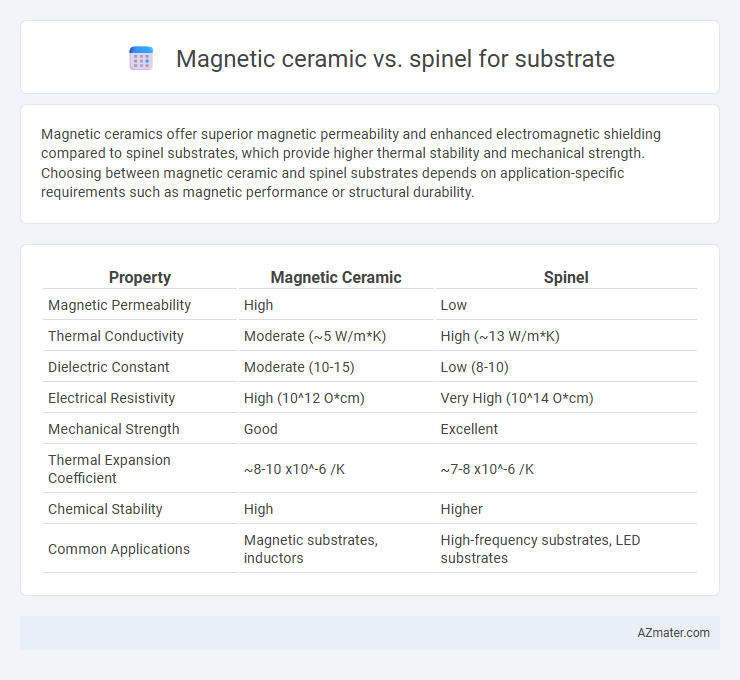Magnetic ceramics offer superior magnetic permeability and enhanced electromagnetic shielding compared to spinel substrates, which provide higher thermal stability and mechanical strength. Choosing between magnetic ceramic and spinel substrates depends on application-specific requirements such as magnetic performance or structural durability.
Table of Comparison
| Property | Magnetic Ceramic | Spinel |
|---|---|---|
| Magnetic Permeability | High | Low |
| Thermal Conductivity | Moderate (~5 W/m*K) | High (~13 W/m*K) |
| Dielectric Constant | Moderate (10-15) | Low (8-10) |
| Electrical Resistivity | High (10^12 O*cm) | Very High (10^14 O*cm) |
| Mechanical Strength | Good | Excellent |
| Thermal Expansion Coefficient | ~8-10 x10^-6 /K | ~7-8 x10^-6 /K |
| Chemical Stability | High | Higher |
| Common Applications | Magnetic substrates, inductors | High-frequency substrates, LED substrates |
Overview of Magnetic Ceramics and Spinels
Magnetic ceramics, composed of ferrite materials like barium ferrite and strontium ferrite, exhibit high electrical resistivity and low eddy current losses, making them ideal for microwave and high-frequency applications. Spinels, characterized by their cubic crystal structure with general formula AB2O4, provide exceptional chemical stability, mechanical strength, and electrical insulation, frequently used as substrates in electronic devices. The choice between magnetic ceramics and spinel substrates depends on specific electromagnetic properties, thermal conductivity, and mechanical durability required by the application.
Composition and Structure Differences
Magnetic ceramic substrates primarily consist of ferrite compounds with iron oxide (Fe2O3) combined with other metal oxides, resulting in high magnetic permeability and good electromagnetic interference (EMI) suppression. Spinel substrates feature a cubic crystal structure composed of magnesium aluminate (MgAl2O4) or similar oxides, offering excellent thermal stability and mechanical strength due to the tightly packed oxygen ions in the spinel lattice. The key structural difference lies in magnetic ceramics' ferrimagnetic spinel-type lattice, compared to the non-magnetic, electrically insulating spinel structure in spinel substrates.
Magnetic Properties Comparison
Magnetic ceramics exhibit higher magnetic permeability and saturation magnetization compared to spinel substrates, making them more suitable for applications requiring strong magnetic response. Spinel substrates typically have lower magnetic losses and better thermal stability but possess weaker magnetic properties overall. The choice between magnetic ceramic and spinel depends on the trade-off between magnetic performance and thermal or mechanical reliability in device fabrication.
Electrical Conductivity and Insulation
Magnetic ceramic substrates typically offer lower electrical conductivity compared to spinel, making them ideal for applications requiring enhanced insulation properties. Spinel substrates, composed mainly of magnesium aluminate (MgAl2O4), exhibit excellent electrical insulation and thermal stability while maintaining moderate dielectric constants. The choice between magnetic ceramic and spinel substrates depends on balancing electrical conductivity needs with insulating performance for specific electronic and microwave device applications.
Thermal Stability and Performance
Magnetic ceramic substrates exhibit superior thermal stability with operating temperatures often exceeding 1200degC, making them ideal for high-performance applications requiring consistent magnetic properties under extreme heat. Spinel substrates, composed primarily of magnesium aluminate, offer excellent thermal shock resistance and thermal conductivity but typically have lower maximum operating temperatures around 1000degC. The choice between magnetic ceramic and spinel substrates depends heavily on the specific thermal demands of the application, with magnetic ceramics favored in ultra-high-temperature environments and spinel providing a balance of thermal stability and mechanical robustness.
Chemical Resistance and Durability
Magnetic ceramic substrates exhibit superior chemical resistance due to their stable oxide composition, making them highly resistant to corrosive environments compared to spinel substrates. Spinel substrates offer excellent durability and thermal stability but are more susceptible to chemical degradation under aggressive chemical exposures. Selecting magnetic ceramic substrates enhances longevity and performance in harsh chemical applications, whereas spinel substrates are preferred for moderate chemical resistance combined with mechanical strength.
Compatibility with Thin-Film Deposition
Magnetic ceramic substrates exhibit excellent compatibility with thin-film deposition due to their high thermal stability and chemical inertness, which reduce stress and improve film adhesion. Spinel substrates offer superior lattice matching and thermal expansion coefficient compatibility with various thin films, minimizing defects and enhancing film quality. Both materials support high-quality thin-film growth, but spinel's crystalline structure often results in better epitaxial alignment compared to amorphous magnetic ceramics.
Applications in Electronics and Magnetics
Magnetic ceramic substrates offer superior dielectric properties and high magnetic permeability, making them ideal for microwave and radio-frequency applications such as antenna components and inductors. Spinel substrates are valued for their excellent thermal stability, mechanical strength, and moderate magnetic properties, which suit them well for electronic packaging and magnetic sensors. Both materials support miniaturization and enhanced performance in electronics and magnetics, but magnetic ceramics excel in high-frequency situations while spinel is preferred for robust, thermally demanding environments.
Cost and Manufacturing Considerations
Magnetic ceramic substrates typically have lower raw material costs compared to spinel, benefiting cost-sensitive applications, but they often require more complex manufacturing processes involving precise sintering conditions to maintain magnetic properties. Spinel substrates offer superior thermal stability and mechanical strength, which can reduce defects and improve yield in mass production, though their higher material expense and brittle nature may increase machining difficulties and tooling wear. Manufacturing considerations for spinel include the need for controlled atmosphere sintering to prevent phase changes, while magnetic ceramics often demand careful doping and grain size control to optimize magnetic performance without driving up production costs.
Choosing the Right Substrate: Key Factors
Magnetic ceramic substrates offer superior magnetic permeability and thermal stability, making them ideal for high-frequency electronic applications requiring efficient electromagnetic interference (EMI) shielding. Spinel substrates excel in mechanical strength and thermal conductivity, providing excellent dimensional stability and resistance to thermal shock under high-temperature conditions. Selecting between magnetic ceramic and spinel substrates depends on application-specific requirements such as magnetic performance, thermal management, mechanical durability, and cost-effectiveness in advanced electronic devices.

Infographic: Magnetic ceramic vs Spinel for Substrate
 azmater.com
azmater.com